Amwell Lime kiln
By Dick Dixon
Click on pictures to enlarge
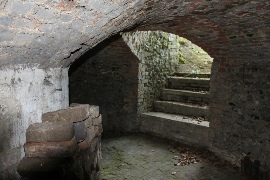
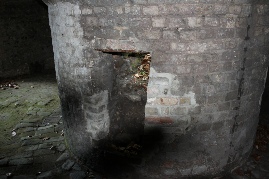
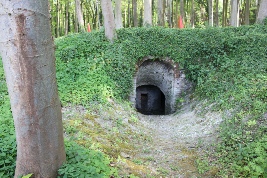
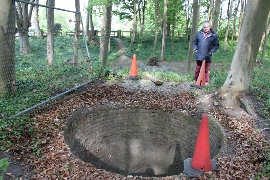
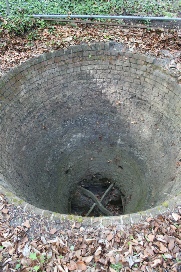
LIME KILN DISCOVERY
by Dick Dixon
We have been contacted by Elizabeth Hawkins, of the Ranch House, Amwell Hill, Great Amwell, practically on our doorstep, who reports that she has a limekiln on her property in its original condition and kindly offered us the opportunity to photograph it. l therefore visited her and took the accompanying photos shown here.
Mrs. Hawkins’ email to us told an interesting tale. Next to her property is the Water Board Pumping Station and an area of woodland. When the Hawkins heard that the Water Board wished to sell a small parcel of woodland, they bought the plot and then noticed a large lump on it, overgrown with greenery and brambles. Mr. Hawkins, who is a builder, cleared the vegetation and discovered beneath it was buried an ancient brick limekiln. This I can describe as tulip shaped, with a wide globular shape at the base and a narrower waisted area above it. It is about 18 to 20 feet from top to base and has three apertures in the base, presumably where the quicklime was extracted.
At its base it can be entered through an archway, where inside were found some corroded parts of a metal grating. Inside it is quite commodious and is well constructed. The brickwork is in very good condition, although repairs to it can be found, showing long usage. David Perman, Ware historian, has visited the site and believes the bricks to be locally made Ware bricks. I would describe them as yellow stocks. It is difficult to date the kiln which was mentioned in Kelly’s Directory of 1874, but it could be much older.
But Mrs. Hawkins story does not end there. Some time ago a lady from Hastings
who was a wartime evacuee in the 1940s at the Ranch House, paid an unexpected visit
to her old wartime home. The Hawkins were not at home at the time so the lady left
a letter explaining who she was. Later it transpired that she had photographs and
a plan of the grounds, which overlooks the New River, showing that it used to have
huts there and a caravan, as it was a roadside tea-
In Stanstead Abbotts, in Cappell Lane, is a path near the Wilberforce Cottages leading up to Easneye which was known as Limekiln Lane, leading up to a chalk quarry. It is believed that limestone was once dug here for use in a limekiln, but no trace of this remains.
LIMEKILNS
Limekilns were used as ovens in which limestone was burnt in order to reduce it to a powder known as quicklime, which had more than one use. The process is a chemical one known as calcination, converting calcium carbonate to calcium oxide. The use of quicklime is very ancient, when wood was very cheap and plentiful, but most limekilns of the 19th century used a mix of wood and coal to produce the heat required to complete the process. It could take a whole day to load the kiln with layers of fuel and limestone and a day to unload it, with a complete ‘burn’ taking a whole week.
Early civilizations used quicklime as building mortar and for stabilising mud
floors. It was also later used in agriculture as a fertilizer, correcting the
acidity of soil, but this use only became possible from the late 13th century when
coal became cheap enough. Small-
Dick Dixon
Footnote:
Stanstead Abbotts had it's own Lime Burner, his name was John Roat, born about 1804 at Hoddesdon Herts. He moved to the village and in 1841 was living with Charles Green, a Master Carpenter in Chapel Lane. In 1842 he married Susanna Waller, and by 1851 he was living in the High Street, as a Master Bricklayer employing 12 men. The 1861 census shows him still living in the High Street, and classed as a Master Bricklayer/Lime Burner employing 5 men. John died in 1869.
Gerald Coppen